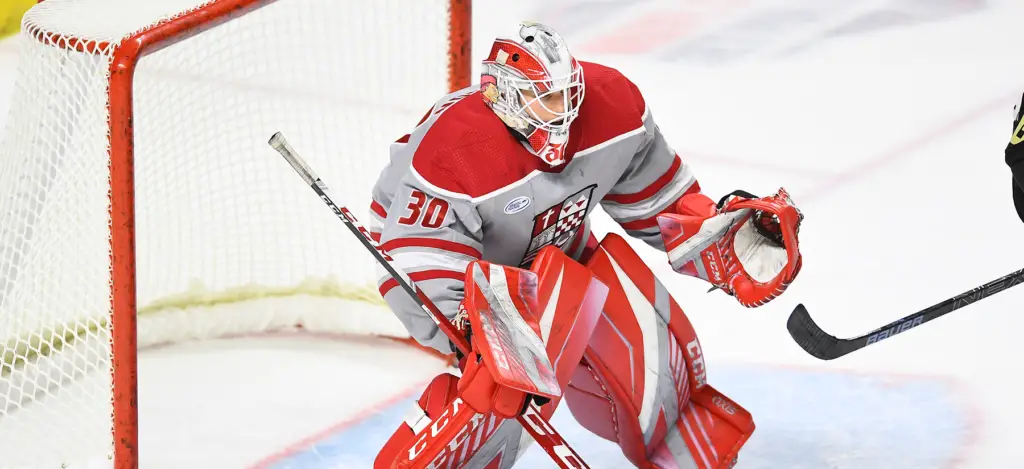
A macabre irony sank over the MassMutual Center during the January 26 game between Sacred Heart and American International.
The two programs were the only 20-win teams in Atlantic Hockey last year, and their last game wound up against one another after COVID-19 canceled the postseason. That game, a 5-3 win for the Pioneers, was an instant college hockey classic emblematic of the first- and second-place teams in the league.
The way the season ended and the way this year scheduled five matchups against one another only heightened the anticipation of watching the two combatants against one another. It escalated further when Sacred Heart monetarily paused its program, and the star power on each team made everyone hold their breath when they finally and inevitably met up.
Hence the dark humor when Sacred Heart was still undermanned, with only five games under its belt, against an AIC machine with an 8-1 league record at the time. A lopsided 8-2 score ensued, a much-heralded matchup falling victim to the larger reality under the surface. That reality was that the disjointed stops and starts in Connecticut needed some traction.
Two weeks later, a staging happened and exposed a much clearer picture of Sacred Heart’s team. Steadily improving performances played a one-goal game against Army West Point, and a February home opener resulted in a third period comeback. The shootout loss sprung the team into its next weekend against Bentley, where six points rolled in a breakout categorized by the red and white tide rolling in from Fairfield County.
“AIC was a terrific team that deserved to be where they were for that game,” Sacred Heart coach CJ Marottolo said. “A lot of our top guys were still in protocol. It was good to get playing again, but we were talking about building step by step, as simple as that sounds. We had more of our team back against Army West Point, and we thought we played well that entire weekend, but we just felt, as a team, we weren’t playing yet. We took our steps and grew every game.
“Since coming off of our pause, I’m really so proud of these guys. They’ve been really focused, and we’re just trying to get a little better every day to work towards the playoffs.”
The team’s performance is a big reason why heads snapped back towards Sacred Heart after the Pioneers were quiet in the first half of the season. Six different players scored goals against Bentley, and the series was only really tied for one full period across either night. Austin Magera scored five minutes into the first game, and Todd Goehring staked his squad to a 1-0 lead near the seven minute mark of the second period in the second.
Bentley used the power play to tie Sacred Heart late in that second period, but the 1-1 score lasted 40 seconds before Braeden Tuck put the Pioneers ahead to stay. A late goal with under a minute aside, it was a dominant performance by a team that saw every geometric angle on the ice. Crisp passing and fundamentals sprung open ice looks and odd-man rushes, and every line scored at least once with three different lines scoring on each individual night.
“A lot of it is playing off one another,” Marottolo said. “They move to support the puck, and having support above and below the puck is crucial. Our guys understand the spacing and what we were trying to do, and it created the two-on-ones that we were trying to create.”
It coupled with a return to form by goalie Josh Benson and his first shutout one year after he recorded five goose eggs in a 20-win season. He slammed the door on the Falcons and followed it up with just under 30 saves in this week’s to Army West Point before Luke Lush posted 25 saves in an overtime performance.
“He struggled at AIC, but our whole team did,” Marottolo said. “We need him to be really good to have a chance, and he’s been working really hard. He was able to work on his game a lot (individually), and I’m glad he’s being rewarded.”
Sacred Heart is still one of the toughest outs in the league, and this week’s games against Army West Point only proved how difficult it is to knock the team out. The Pioneers responded to Black Knight goals in both games, first by scoring on the power play about a minute after giving up a shorthanded bid and then by notching a game-tying goal in the overtime loss on Tuesday night.
It has the team poised to transform into Atlantic Hockey’s wild card for the late stretch of the season. The consecutive losses against AIC and Army West Point dropped Sacred Heart to 2-3 record and tumbled the points percentage from third place into ninth. The team’s response against Bentley subsequently brought it back into home ice, and the outcomes against Army West Point weren’t enough to move SHU out of seventh place.
The frenetic schedule guarantees that will likely change at some point. Sacred Heart is scheduled to play eight games over the last 15 days of the season, and half of the remaining six Atlantic Hockey games are scheduled against AIC. Three games against Holy Cross and Bentley are spread across four days, with the Tuesday night game at Bentley nestled between four consecutive home games.
“Once we got back together, we (developed) the mindset that our playoffs were starting now,” Marottolo said.
A season for the ages
This season was always going to be remembered for a number of reasons, but 2020-2021’s run at the Atlantic Hockey record book is going to make for an interesting conversation because a number of longstanding, hallowed numbers are potentially going to fall.
– Seven offenses in the league’s previous 17 years averaged four goals or more per game, and Mercyhurst holds the top three spots from seasons in 2003-2004, 2005-2006 and 2008-2009. This year’s Robert Morris team is at 4.15 goals per game, less than 0.05 points lower than the Lakers’ third entry and 0.01 better than both RIT’s 2006-2007 and the Colonials’ 2015-2016 campaigns, good enough for fourth at the current moment.
– AIC joins RMU in a potential top-10 season with an average of 3.92 goals per game. The number is just below Air Force’s ninth place, 3.93 season from 2010-2011 and decisively better than RIT’s 3.89 goals per game in 2009-2010.
– The Yellow Jackets are more likely to angle for one major record once they formally return to game action. Three of their last four games played were shutouts, and their team average for goals against dropped decisively to 1.50 goals per game. That’s nearly a full one-third goal per game better than the 1.82 goals allowed by both Army’s 2007-2008 team and RIT’s 2009-2010 team.
– RMU is also attempting to become the first team to record a second season with a power play conversion rate over 30 percent. The Colonials are currently at 28.9 percent, fourth-best in league history and behind Holy Cross’ 2010-2011 season, but they went over 30 percent just five years ago in 2015-2016. The league record is an even 31 percent held by Bentley’s 2013-2014 season.
– Because the record book only requires 50 percent of games played for skaters and 40 percent of minutes played for goaltenders, a number of individual records could also fall. In terms of goal scoring, no skater has ever scored an even one goal per game, but Jonathan Bendorf has 10 goals in 12 games for Mercyhurst, and Colin Bilek has nine goals in 11 games for Army West Point. Both would land in the top-10 at that rate.
– From an assist standpoint, AIC’s Brennan Kapcheck is averaging 1.08 helpers per game, a number just behind Mercyhurst’s Jamie Hunt. Hunt averaged 1.11 assists per game in 2005-2006, one of two years definitively over 1.00 per game. Bentley’s Luke Santerno is actually directly at one assist per game, a number that could tie him with four years exactly at the 1.00 mark. Two of those years happened in the same year when Quinnipiac’s Red Cashman and Mercyhurst’s Scott Champagne set the league record one year before Champagne and Hunt tied and broke it.
– In the crease, Canisius’ Matt Ladd currently sits at a .946 save percentage, one toe-save worse than the dueling .947 atop the league record books. He’s played in three of the Golden Griffins’ five games, as of press time, with a 1.68 goals against average.
– That GAA would actually tie Air Force’s Shane Starrett for second all-time, but it wouldn’t even win the goaltender championship for this year. That would go to AIC’s Jake Kucharski and his 1.39 GAA, by far a league record as he trades minutes with Stefano Durante, the third-best goaltender in the league this year at 1.71.
– Two prior seasons have two entries on the single-season goaltending GAA list, and Niagara, Army, RIT and Canisius have multiple entries from different seasons. No program has two goalies from the same season though, and this year’s trio would actually drop Niagara and Army from the list. Ladd’s entry, ironically enough, would drop Keegan Asmundson from tenth, himself a former Canisius goalie.
Anyone own an abacus?
This is about the time of year when Chris and I would start consulting our trusty number machines to determine which teams would clinch what scenario in the postseason. It was an annual rite of passage further robbed by COVID-19 because of course it was, and this year’s percentage points format only makes it that much more difficult to determine.
I actually don’t mind the percentage play because it actively hurts teams caught with a loss. No loss is ever a throwaway, but it feels like this year carries that much more of an impact. In a traditional format, AIC would sit three points clear of Robert Morris and 11 points ahead of Army West Point with 12 games played. The possibility of RIT catching the Yellow Jackets with a 15-point deficit would be virtually impossible.
AIC, though, holds an .889 percentage with its 11-1-0-0-1-0 (that’s 11 wins, one loss, one overtime win, for those keeping score at home) because it has 32 out of a possible 36 points. RIT is actually in fourth place with a .630 points percentage and a 5-3-1-1 record (five wins, three losses and a tie that was a shootout win, 17 out of a possible 27) and can actually catch the Yellow Jackets pretty easily. If the Tigers won their next three and the Yellow Jackets lost their next three, RIT would actually pass AIC with a .722 points percentage over a .711 number.
That’s how slim the margin is between first and fourth place, and it only gets closer in the race for home ice advantage. Bentley is 3-8, but three overtime losses mitigate the damage enough to keep the Falcons in home ice. Niagara, meanwhile, only has one league win, but a shootout win and two losses in overtime actually mitigate the percentages to .273.
The Purple Eagles can therefore pass Bentley for home ice with essentially one weekend’s work. One Niagara win would elevate its percentage to .333, an identical number to Bentley with one single regulation loss. Even an overtime loss would provide the slimmest of margins in this regard, though that doesn’t take into account anything from Sacred Heart, Holy Cross or Air Force.
The bottom line is that the season has about two to three weeks remaining, and wins are more premium now than ever before. The hope is always to push the teams across the finish line with full health, and I personally want everyone to be hitting their full stride in time for a postseason rush. With that in mind, it’s important to remember the criticality of every game and just how precious each shift, each period really is in the framework of the season.


